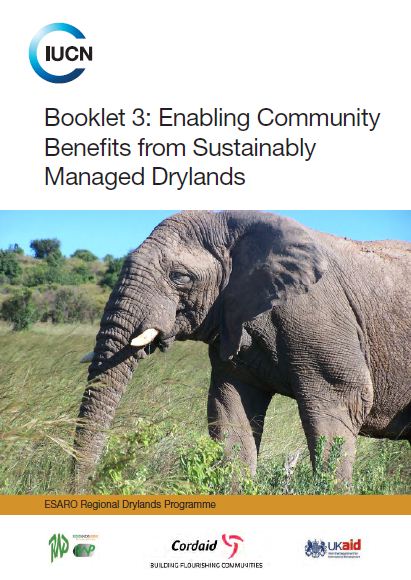Booklet 3: Enabling Community Benefits from Sustainably Managed Drylands
Garba Tula district in Isiolo County of Northern Kenya, is a region covering approximately 10,000km and home to around 40,000 predominantly Boran Pastoralists. The region is characterised by arid and semi-arid conditions and is rich in biodiversity and wildlife resources. Despite being surrounded by protected areas such as Meru National Park and Bisan Adi Game Reserve the full potential for conservation is not being met, and instead communities are often threatened and restricted by wildlife populations. The majority of land in Garba Tula district is held in trust by the country councils, who exercise strict control over the allocation of land. Decisions on the use and management of land are taken out of the hands of local communities and their traditional authorities, weakening them and leading to increased land fragmentation and degradation.

Photo: IUCN ESARO
IUCN’s dryland programme based at the IUCN Eastern and Southern Africa Regional Office (ESARO) has been working in Garba Tula District, of Isiolo County since 2009 implementing the Improving Governance of Natural Resources for Rural Poverty Reduction project with funding from the Department for International Development Governance and Transparency Fund, (DFID-GTF), and complementary resources from Catholic Aid for Relief and Development (CORDAID). This project seeks to strengthen natural resource governance in Garba Tula, by supporting the underlying institutions and regulatory systems, enabling more participatory decision-making practices and positioning communities to benefit from more sustainable resource management. The project has 4 key result areas:
- Decision makers and stakeholders have increased awareness and policy guidance for dryland management based on identified best practices.
- More effective participatory decision-making in natural resource use and management, based on strengthened institutional arrangements
- Local communities are better able to capture viable economic and biodiversity-related benefits from identified dryland ecosystem opportunities
- Lessons and best practices are effectively captured and disseminated to promote learning and enable scaling up of project impacts
These handbooks are the products of this project and are a means to share the learning from the approaches used with a wider audience of practitioners and policy makers. There are 3 handbooks in this series: 1) Strengthening Natural Resource Governance, 2) Participatory Rangeland Planning - A Practitioners Guide and 3) Enabling Community Benefits from Sustainably Managed Drylands.
